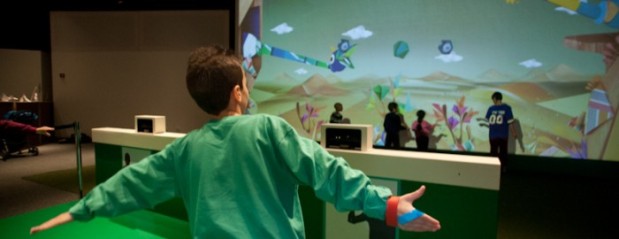
The New York Hall of Science has long had a focus on networks and complex systems science. They have positioned themselves as leaders in communicating Systems Science concepts to young people.
In 2012, the Hall began renovations of their Great Hall, and wanted to create an exhibition addressing sustainability science targeting an audience aged 6-10. Working with creative designers, their challenge was: How do you create an experience around systems science that engages people of that age?
The team responsible for Connected Worlds began by playing with the Sustainability Indicators produced by the Center for International Earth Science Information Network. These are algorithms that allow you to measure, compare and contrast different aspects of how ecosystems function. These algorithms became the framework for an interactive installation in which young people could manage the functioning of an ecosystem.
The first version of Connected Worlds was based on the New York water system, but when the Hall began playtesting, they realised that they’d gone too far toward being literal. Because the system being represented was so familiar, the only thing participants could think about was ‘save water’.
The next iteration made the systems more colourful and abstract, allowing people to be more playful.
The game features six imaginary worlds projected on six huge screens, linked by a giant waterfall. A range of archetypal ecosystems are represented: wetlands, reservoir, jungle, desert, river-valley and plains. The worlds are populated by fictional plants and animals.
There is a fixed amount of water across the whole linked system. Water is stored in the reservoir, evaporates as clouds and consumed by animals and plants. Each ecosystem needs different amounts of water.
The screens each respond to movement. Using gestures, people can cut down trees, plant seeds, pump water and interact with the animals. The health of an ecosystem is communicated through the behaviour of its inhabitants.
Connected Worlds was designed for persistent free play by multiple players. Reflecting the nature of an exhibition, people can come in and out as they choose. The Hall also runs session-based games, in which school groups are prompted to engage with specific scenarios. These scenarios run for 5-15 minutes, followed by discussion and reflection, and then a second attempt at the scenario.
Connected Worlds will be launched properly in late 2014 as part of the 50th anniversary of the New York World’s Fair., so there are currently limited data on how effective it is at engaging and communicating systems science concepts to its audience. Nevertheless, the feedback from initial playtests has been positive. Most importantly, the exhibition is a valuable experiment in how to engage young people with systems science concepts.